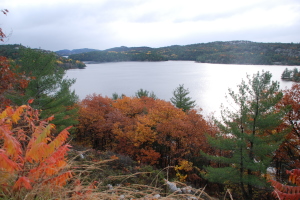Dreamers Rock – Spirit – Manitoulin – Little Current
Special Spiritual Place – To Dream: Learning about Native Culture
by Back Roads Bill
Nearly every culture in human history has sought to honour the divine, the mysterious, the supernatural, or the extraordinary in some way. Most often this happens at sacred sites – special places where the physical world seems to meet the spiritual world.
 For Jonathan Pitt Dreamer’s Rock has spiritual significance. He is of mixed First Nations ancestry and a member of the Canadian Métis Council. He teaches within the Aboriginal Teacher Certification Program and is a teacher of Anishnaabemwin (Ojibwe) as a Second Language Program at Nipissing University’s Schulich School of Education. The promontory is located near the gateway of Manitoulin Island, on the way to Little Current. It commands a view of a protected water passageway in all directions, along with the stunning white quartzite of the La Cloche Mountains.
For Jonathan Pitt Dreamer’s Rock has spiritual significance. He is of mixed First Nations ancestry and a member of the Canadian Métis Council. He teaches within the Aboriginal Teacher Certification Program and is a teacher of Anishnaabemwin (Ojibwe) as a Second Language Program at Nipissing University’s Schulich School of Education. The promontory is located near the gateway of Manitoulin Island, on the way to Little Current. It commands a view of a protected water passageway in all directions, along with the stunning white quartzite of the La Cloche Mountains.
“Dreamer’s Rock has been used since time immemorial as a sacred ceremonial place by Native peoples” said Dr. Pitt. “Fall is a time of cleansing and Dreamer’s Rock is still used today as it was since the Creator created us; for fasting, vision and sweat lodge ceremonies at the summit of Dreamer’s Rock. In times gone by, Dreamer’s Rock was used as a rite-of-passage for Native youth who would fast until they had a vision.”
“Dreamer’s Rock is a spiritual place, as an Aboriginal person it stirs something deep inside me when I am there. Blood memory gives us a strong connection to the land. The rock speaks to me, not in words, but in a different way of knowing,” said Dr. Pitt. Just as there is different ways learning, there are also different ways of knowing beyond the textbook style knowledge. Often when I have dreams, they come true. What I mean is that often things will happen and I will remember these things have happened in my dreams before, like a glimpse into the future.”
Dreamer’s Rock has influenced writers and artists such as the well-known Basil H. Johnston (Anishinaabe scholar and educator) who  wrote a poem about Dreamer’s Rock in 1974 as well as prolific writer Drew Hayden Taylor who wrote a play titled: ‘Toronto at Dreamer’s Rock’ in 1990. You can Google both references. Murray Leatherdale’s 1975 book ‘Nipissing from Brule to Booth’ also mentions Dreamer’s Rock regarding fasting and vision quests.
wrote a poem about Dreamer’s Rock in 1974 as well as prolific writer Drew Hayden Taylor who wrote a play titled: ‘Toronto at Dreamer’s Rock’ in 1990. You can Google both references. Murray Leatherdale’s 1975 book ‘Nipissing from Brule to Booth’ also mentions Dreamer’s Rock regarding fasting and vision quests.
Dr. Pitt said that across the channel from Dreamer’s Rock is the ‘bell rock’ from which the La Cloche islands draw their name. The bell rock was once a large boulder, now broken but one of the pieces still rings. It is on private land in a quarry and is not accessible. However, it remains paramount to this location as it was used as a warning bell from Birch Island to Manitoulin, as a signal for ceremonies or gatherings and to signal to canoes on the water highway during the fur trade. It is important to note that on this canoe route east in Killarney Provincial Park area there is pictograph sites.
Pictographs often display the past dream experiences of the artist. It is not unreasonable, that an artist after having a dream or vision at Dreamer’s Rock could have created these pictographs, perhaps using ochre from “Porte de l’Enfer” or “Hell’s Gate” (one of only two Native ochre mines in the province) found on the Mattawa River. Recently, other spiritual type sites such as Pukaskwa Pits (like those found on the North Shore of Lake Superior) have been found in the neighbouring Killarney Park area. Manitoulin Island is also home to the 9, 500 year old radiocarbon dated timescale (11,000 real calibrated years) Sheguiandah Paleo-Indian archaeological site and Mindemoya burial cave among others.
There is a historic plaque at Whitefish River First Nation that was erected in 1971. It says: “This tall quartzite rock derives its name from a local Indian tradition that was used for dream visitation. On reaching puberty, Indian boys of the surrounding area were sent to the summit where they fasted and, through dreams, received powers from a “guardian spirit.” The spirit would also advise them of their calling. Shaw-wan-ossy-way, a famous chief and medicine man of the early 1800s, is reported to have acquired his healing powers after several visits to this rock where he lay in the shallow five-foot depression at the summit. Little used after the arrival of the Europeans, “Dreamer’s Rock”, with its incomparable view of the surrounding countryside, stands as a reminder of ancient Indian beliefs.”
For the native people of North America, the quest for a guardian spirit or “manitou” seems to have been one of their most important religious customs. This search, undertaken at the age of puberty, usually entailed inducing visions through fasting and solitude. Such dreams amounted to communion with the spirits and were often seen as predictions of the future. The spirits were everywhere in nature: “They make the grass and plants grow, the winds blow and the clouds float across the sky …”
Historic Location and Interpretation
Dr. Pat Julig is an archaeologist, from Laurentian University; he is the author of ‘The Sheguiandah Site’ – “Archaeological, Geological and Paleobotanical Studies on Manitoulin Island, Ontario.”
He offered this learned interpretation of the site. “The Dreamers Rock is on Lorraine formation quartzite, courser and less useful for stone tools, and is not an ancient quarry or manufacturing site. Since it is a prominent quartzite outcrop and landmark at the entrance to the North Channel travel route, it would be special in many ways.
“If you were heading eastbound from there it may indicate the start of a journey into some more dangerous waters, until reaching the protected channel of Collins Inlet, past Killarney. Westbound it would indicate the arrival at the more sheltered North Channel waters,” he said. “It may be a place to stop and rest, and possibly trade. It is on the voyager route, and the Bell rocks were nearby. I see it as more as of a historic era site, possibly as a vision quest site.” It would be a significant cultural landscape marker, in my opinion. It may also be the place to meditate and seek a vision quest, as the name suggests?”
There was a CBC TV series back in the early 70’s called ‘Adventures in Rainbow Country’ with an episode on Dreamer’s Rock. As a result of the program, the Sudbury and Manitoulin Districts are to this day known as the Rainbow Country tourist region. Within the storyline of this episode, Dreamer’s Rock is slated to be a mining development on a sacred land. YouTube: Dreamer’ Rock Rainbow Country. There are some really good footage of the site during the program. (Watch the23:26; some things have changed.)
Permission to Visit
Dreamer’s Rock has an elevation of 250 metres or 821’ and is located at N46°00.500’ W81°45.988’ or WGS 84 17 T E440608 N5095165 on the east side of Highway 6 on Sunshine Alley Rd (Rainbow Lodge). Contact Whitefish River First Nation to visit Dreamer’s Rock. This journey is worth it. The office is six kilometres (km) before or north of Sunshine Alley Rd. You can obtain permission, at the administration’s office, 17A Rainbow Ridge Road on Birch Island. Call 705-285-4335 or fax 705-285-4532; by email receptionist@whitefishriver.ca. The Dreamer’s Rock site is adjacent to the Pow-Wow grounds, about 500 m from Highway 6.
As an alternative there is an expansive view of the promontory, from the north looking south, along the Willisville Rd., on the east side of Highway 6, just before Whitefish Fall Rd, 11 km before Birch Island and the Whitefish River First Nation’s administrative building. It is a spiritual place and photos are not allowed.
In the a 2008 Heritage Trust (an agency of the Government of Ontario), publication it says: “…Although Dreamer’s Rock has long ceased to be used as a site for inducing visions of the future, it can offer those who climb it a bracing panoramic view of the countryside…” The view statement is correct, the vision reference is not.
It is an easy and short walk. When you reach the pinnacle you will lie down on the smoothest rock you will ever feel. Although static, it provides the comfort and fluidity of a convex orthopaedic table. Close your eyes, feel the presence of mind, body and spirit.
